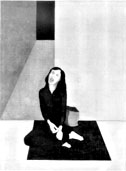|

Comment
on this story
What:
Walking Between Two Skies and Marybeth Boyanton's silk art
Where:
Nomad Gallery, 31 Market Square
When:
Through August, with an open house and reception Friday, March 22 from 5-8:30 p.m.
Call 522-9594 for information.
|
|

A unique shop welcomes spring with a new show
by Heather Joyner
Something often happens to amaze me whenever I'm feeling particularly fed up with Knoxville—it's as if a slap is promptly delivered if I even consider biting the hand that feeds me. For instance, driving up a hill from the commercial squalor of Sutherland Avenue I find art—really good art—where I least expect it: in a house at the end of a road originating at all that mess below. This time, it's art from Rick Whitehead's boundless imagination. As he prepares his 12-piece series called Walking Between Two Skies for delivery to Emily Dewhirst's Nomad Gallery, Whitehead tells me about the paintings on silk begun a decade ago that will grace Market Square beginning March 22.
Using Japanese sumi ink, Whitehead creates images that can be seen from two sides. The hard-to-come-by ink, most often used as black on white (with perhaps a touch of red), is actually available in a range of colors. Whitehead explains that when various substances are burned, they produce pigment that adheres to a metal surface. The pigment is then scraped off and pressed into sumi ink sticks. Whitehead has narrowed his palette to 10 colors after leaving numerous sticks half-covered in sunlight to test their permanence, and he praises the ink's ability to be layered without "lifting off." Indeed, the effect is both vivid and subtle. The fine grain of silk substrate shows through just enough to become one with the color, yet its opacity conceals shifts occurring on the opposite side. Whitehead's is an innovative approach that reflects his background in chemical engineering but transcends gimmickry. The motivation for his process and the three-dimensional form it assumes reveal an artist's perspective and objectives.
Whitehead remarks, "Originally, I'd notice a reflection of one of my paintings in a mirror and think about how different it appeared—that other dimension, like seeing a construction in space from behind, [has a] psychological element—the image is obverse/ reverse in more ways than one."
Looking at his mostly figurative paintings (recently exhibited in Belgium and Spain), I understand what he means. Whether they feature an old woman facing outward on one side, her head slumped forward on the other, or less obvious differences from front to back, Whitehead's work demands an adjustment on the viewer's part. As our eyes shift from one surface to its backside, we must acknowledge the act of seeing and the failings of memory (however brief). And our challenged visual perception sparks questions regarding our emotional perception of the artist's subject matter.
The crippled, addicted, and/or dejected "street people" Whitehead presents in Walking Between Two Skies may seem a strange choice given their delicate and ethereal treatment. The artist does not know the individuals he paints, but says he picks up on a feeling they project that he finds moving.
"I create a vision about that. A person has to have a certain aura, a particular beauty for me to paint them. I later reconstruct that vision, using models to bring it forward." Whitehead refers to his reaction as coming from "pure research; you're intrigued and you walk inside, enter into these people's worlds."
Once a student at the Pennsylvania Academy of Fine Arts, Whitehead has long been interested in Persian miniatures. He says, "like a mandala, they carry you into a different reality; they create a space in your mind." He tells me that separate reality or alternative mental state is what he's striving to evoke through his own work—a lofty goal, yet one he quite possibly achieves.
Also displayed at Nomad is fiber art by Marybeth Boyanton. Her meticulously-crafted pillows with Caribbean colors and "scenes" inhabited by sumptuous nudes complement Whitehead's series. Possessing an entirely different tone, Boyanton's handiwork allows a sort of tropical reprieve from Whitehead's generally stark viewpoint. Knoxville again catches me off guard, for I know Boyanton to be an accomplished writer rather than this divine witch of stitchery.
I am more familiar with Nomad's charms, although it surprises me on occasion. After renovating and living in her building on Market Square for a few years, Emily Dewhirst opened Nomad's doors to the public. Standing amidst tribal rugs in the warmth of the gallery's 19th-Century wood floors and brick walls, Dewhirst quips, "Sometimes I look like I've been here since the 1800s." She nevertheless exudes energy. Now in her 70s, the fiber artist, mother of four, recent Peace Corps volunteer, and globetrotter adheres to a schedule that might exhaust people half her age.
Her trip this winter to India and Nepal has helped restock the pond that is Nomad's collection. If you appreciate skeins of brightly-colored wool, ethnic dolls, velvet pouches stuffed with darjeeling tea, kites, folk tapestries, paper lanterns, chunky jewelry, bamboo backscratchers, Ecuadorian hats, etc., Nomad is your kind of place.
Dewhirst says she plans to continue showing artists' works twice a year—in fall and spring—and that she is pleased with the Kinsey proposal for the Square. "I think it's the most non-threatening, solid hope for Market Square making it," she tells me. When I ask why she risked working so hard on a property that could have been taken away, she says, "This is my home. I can't do otherwise." Nomad is a "home" for us to enjoy as well, and it provides yet another venue for local artists. We are lucky to have it and the individualistic, homegrown spirit it represents as we decide Market Square's fate.

March 20, 2002 * Vol. 12, No. 12
© 2002 Metro Pulse
|